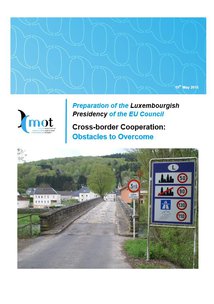Legal instruments
Overview
A legal instrument suited to the cross-border project
The content of the initiative evolves over time and the legal instrument needs to be suited to the project’s aim. Cooperation initiatives are not linear processes but rather iterative ones. From the initial definition of the project’s objectives to the implementation of a cross-border facility, through to a more integrated form of cooperation, the tools that the players concerned can use will change in accordance with the approach adopted.
Cross-border strategic planning
Cross-border “strategic planning” takes the form of the formalisation of a common outlook, the preparation of an overall project for the territory (in the form of a charter, a white paper, a set of objectives) and concrete cross-border projects in different areas. These elements, defined jointly, must be transposed into the respective local planning documents.
It is usually formalised by a cooperation agreement signed between the partners. This approach, which has not been implemented on all cross-border territories, nevertheless plays a strategic role, since it enables overall definition of planning issues and coordinated development of the crossborder territory.
Consultation between players with a view to achieving common objectives
Local players wishing to consult with one another with a view to coordinating their actions and defining cooperation objectives can formalise their exchanges by setting up an association-type structure. If this structure is not competent to carry the project(s) decided on by its members, it can nonetheless constitute a forum for exchange and consultation in the early stages of project development. Cross-border associations (see the topic “tools”) can also, in the later stages, carry out promotion actions, lobbying and studies for the entities sponsoring the projects.
Establishment and management of cross-border services and facilities
The operational phase covers investment in and implementation of the cross-border projects of local actors. It concerns both the establishment of cross-border services (services to persons, transport, tourism, social or cultural action, etc.) and the provision of cross-border facilities and developments. The partners must identify novel, experimental solutions for operating the service or facility on the scale of the cross-border territory by combining the various mechanisms for funding, for action by the partners and for personnel recruitment on either side of the border.
Players can also coordinate these actions via an agreement, with the signature of a multi-party agreement serving as a framework for their cooperation. Depending on the project’s characteristics and how advanced it is, they can also opt for the institutional channel via the setting-up of a cooperation grouping (LGTC, EGTC, ECG, etc.).
Integrated approaches in cross-border territories
The legal framework provides a conventional response to the establishment and management of cross-border public services and facilities.
In order to last, cross-border cooperation must not be limited to individual projects. Some cross-border territories have introduced “integrated approaches” based on overall political leadership of the territory, in order to provide a joint response to the expectation and needs of the inhabitants.
These projects take various names (Eurocity, Eurodistrict, Euroregion) according to the territorial scale concerned. From the legal point of view, continuity of cross-border approaches must be ensured within the framework of a permanent organisation. This organisation is established using cross-border cooperation instruments dedicated initially to the management of cross-border public services and facilities (LGCC, European District under French law, etc).
Multi-level cross-border governance: a vertical and horizontal partnership
Multi-level governance aims to achieve organisational, territorial and institutional cohesion over a cross-border territory by promotion of dialogue between all the public and private actors at local, regional and national levels concerned by the development of the cross-border territory.
It is an essential component of the preparation of viable cross-border cooperation projects based on a horizontal partnership (all the local private and public actors concerned must participate in project definition and implementation) and/or on a vertical partnership (between the political and technical levels). The objectives are as follows: political leadership, long-term vision and knowledge of the socio-economic and cultural realities of the cross-border living area.
The EGTC is likely to play a role in strengthening cross-border governance by allowing a State, with its regulatory power, to be a member of a cross-border structure alongside local authorities. This new instrument is likely to provide cross-border cooperation actors with a “forum” for discussion in order to draw up innovative and ambitious measures adapted to cooperation actions.



